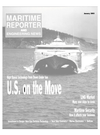
Price, Quality, Schedule
That's the sign I saw once in a Maine boatyard. Big, bold letters.
Underneath it said, "Pick two". That's the dilemma for any provider of goods or services. Low price, high quality, quick schedule. Our customers want all three objectives, our industry often has challenges in providing just one of those goals.
As the president of a naval architecture firm I have asked myself how we can deliver a better product on schedule at a competitive price. If a tradeoff must be made, do clients want lower cost and higher risk in the shipyard?
Do they understand that a properly scheduled job allows for better shipchecks and good information (hopefully) from the vendors? If budget is the overriding issue, what documents need to be produced by the engineering firm to achieve that result?
As I write this I am returning from a meeting with an unhappy customer.
The project involved interiors, subcontractors, federal funding requirements and a 28- year-old ferry. We had missed some items, the shipyard was skilled at identifying change orders, and there were issues related to asbestos, lead paint, and coal tar epoxy. The client was faced with a substantial increase in project cost.
The meeting could have been a rant session on how we failed to provide the superior level of engineering they had come to expect from us. Instead, our collective focus was on identifying problems, seeking their root causes, and creating processes to prevent any recurrence of such problems on future projects. A thread uniting the problems was poor communications.
An engineer's challenge is to communicate with a customer about their explicit and implicit requirements.
The engineer can then prepare calculations and designs using the principals of physics, appropriate regulations, and accepted design standards. He/she must then capture that work in documents, generally plans, specifications, and estimates. These documents form another type of communication with vendors, shipyards and regulatory agencies. This paperwork allows these other entities to conduct their own assignments of supplying equipment, building the vessel, and verifying that requirements have been met.
This client meeting I mentioned above allowed the engineer and the shipowner to exchange ideas on how to improve communication. As the engineering firm we need to hone our skills in eliciting information from the customer and then presenting what we think we heard back to the client. The shipowner needs to get clear direction and buy-in from their own internal customers. Collectively, we recognize that quality efforts in the design package reduces cost growth in the shipyard.
It results in better bids with less risk of litigation at the end of the project.
My advice to the industry at large is to use the Maine boatyard sign as a starting point for communication. Use emails, letters, reports, sketches, checklists, models, renderings, and memos. Seek out whatever works to generate a dialogue about a project.
Assume nothing. Ask questions and repeat back the answers. Time spent on these communications tools at the beginning of a project will help avoid surprises and increased cost. I can assure you that the Elliott Bay Design Group team will be focussing on good communication with our customers, vendors, and shipyards.
Read Price, Quality, Schedule in Pdf, Flash or Html5 edition of January 2003 Maritime Reporter
Other stories from January 2003 issue
Content
- Alaska Awards Metlakatla Ferry Contract to Conrad page: 8
- King Named CEO for VT Halter Marine page: 8
- Halmatic Pilot Boats for Spain's Atlantic Coast page: 10
- Bollinger Delivers Ms. Sara Jane page: 11
- Air-to-Sea Technology Transfer page: 12
- Southbury LES:"Outages are Not Acceptable" page: 15
- Nera Introduces F33 page: 18
- Sending Screws, Pistons and Lube Oil via Satellite page: 19
- SeaWave Makes Maritime Communication Seamless page: 19
- The Maritime Transportation Security Act 101 page: 20
- Underwater Intervention 2003 Set for New Orleans page: 24
- Cygnus Thickness Gauge Designed for VideoRay page: 25
- Halmatic Building World's Tallest Yacht Mast page: 26
- To the North, South And A Little Island Sheltered page: 27
- A New England Shipyard Comes of Age page: 32
- Derecktor Expansion in Bridgeport Extends Capabilities page: 34
- Price, Quality, Schedule page: 35
- Manufacturing Better Bearings for the Marine Industry page: 36
- Old Dominion Gets New Research Vessel page: 37
- Speed to Spare page: 38
- LSA Enjoys Strong Orderbook page: 40
- Aircraft Carrier of the Future page: 43
- Cummins Introduces the QSK60 page: 44
- Emission-Reduction Test a Success page: 44
- AMSC Passes Milestone page: 44
- Workboat 2002 Round-Up Bollinger to USCG: 50 Boats and Counting page: 46
- Scanjet's Tank Cleaning System Reduces Vessel Turnaround Time page: 46
- Alfa Laval Offers New Plate Heat Exchanger Steam Heater Line page: 48
- Danger on the High Seas page: 50
- Market Report: Long-Term Healthy LNG Ship Demand page: 51
- Thales Prepares to take the Market by Storm page: 52


